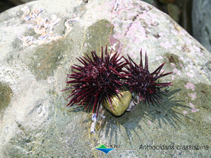Heliocidaris crassispina (Agassiz, 1864)
Purple sea urchin
Classification / Names Common names | Synonyms | CoL | ITIS | WoRMS
Echinoidea | Camarodonta | Echinometridae
Environment: milieu / climate zone / depth range / distribution range Ecology
Benthic; depth range 0 - 70 m (Ref. 81020). Tropical
Distribution Countries | FAO areas | Ecosystems | Occurrences | Introductions
Northwest Pacific: Hong Kong.
Length at first maturity / Size / Weight / Age
Maturity: Lm ? range ? - ? cm Max length : 7.7 cm WD male/unsexed; (Ref. 126588); max. reported age: 11 years (Ref. 126586)
Life cycle and mating behavior Maturity | Reproduction | Spawning | Eggs | Fecundity | Larvae
Main reference
References | Coordinator | Collaborators
Chiu, S.T. 1990 Age and growth of Anthocidaris crassispina (Echinodermata: Echinoidea) in Hong Kong. Bull. Mar. Sci. 47(1):94-103. (Ref. 85020)
IUCN Red List Status
(Ref. 130435: Version 2025-1)
CITES status (Ref. 108899)
CMS (Ref. 116361)
Threat to humans
Human uses
| FishSource |
Tools
More information
Max. ages / sizes
Length-weight rel.
Length-length rel.
Length-frequencies
Mass conversion
Abundance
Internet sources
BHL | BOLD Systems | CISTI | DiscoverLife | FAO(Publication : search) | Fishipedia | GenBank (genome, nucleotide) | GloBI | Gomexsi | Google Books | Google Scholar | Google | PubMed | Tree of Life | Wikipedia (Go, Search) | Zoological Record



